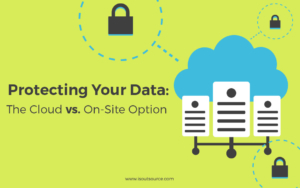
Data protection and cybersecurity are hot topics these days – and with good reason. Your data and your client’s data are your most valuable assets that you need to protect. Which method should you take in ensuring they’re safe? The cloud or an on-premise hardware like an external drive/server? Let’s break down some of the major factors you’ll need to consider before making your final choice.
Cost
On-premise storage is an upfront investment. Since it’s a physical object taking up space in your office, the only real fees you’ll have after installation is based off of maintenance and any upgrades you may (and presumably will) make down the road. A one time purchase can sound appealing, but the kicker is that the cost will be pretty hefty. However, once you have it you can customize however you want without having to cross any red tape.
Cloud storage is often done on a subscription basis. This means buying a plan that works for you and your business, which can be adjusted over time. These plans cover the amount of storage you’ll have available, the amount of users you can have connected, and any other extra security measures and apps you’d like to add on. Whatever plan you choose will greatly impact your final bill. For basic, starter cloud plans you can get away with something cheaper to test the waters. However, the less you pay means the less functionality you’ll likely have.
Security
This is a tricky one to define and it comes down to what you as a company have capacity for. There are two major differences to keep in mind here: on-premise systems will give you full control and responsibility of your data security whereas the cloud leaves that to the vendor you’re subscribing from. There are pros and cons for each.
If you and your team feel equipped to handle your own security, or are willing to outsource to someone who can help you get it set up, then on-premise will give you full control. However, if you’re not up to snuff on cybersecurity and are trying to figure it out as you go, you may be leaving yourself vulnerable to attacks or even human error. Using the cloud, on the other hand, means you can leave it up to the experts at your vendor’s HQ. Granted, there are security plans that you can choose from and systems you can setup to ensure extra protection. But the drawback is you’re putting a lot of faith in a third party. It comes down to whether or not you’re totally comfortable with that. You may also want to consider whether or not you want to invest in a public or private cloud solution, which you can read more about here.
Accessibility
This is where the cloud thrives the most. The very nature of the cloud makes it so that you can access your data from anywhere. This means you don’t have to slow down your workflow if you’re taking a sick day from home or if you have employees who work remotely. Basically right out of the gate, you have total flexibility with how you access your data.
While there are means to create VPNs that will allow you to access your on-premise servers remotely, they can be cumbersome to set up and require a bit more effort. Plus, there can be a steep learning curve for some of your non-IT savvy employees.
Verdict?
On-premise, while not without value, is on its way out. The limits in accessibility make it cumbersome for businesses that are trying to move quickly and want room to scale as they grow. These are all assets the cloud embodies well. The cloud will continue to evolve, making concerns for third-parties handling security less and less of a factor as time goes on. This is a chance to invest in the future of your company and the cloud will move rapidly along with you.
Whether you choose on-premise or the cloud, ISOutsource can help you get your data setup to be as secure as possible. Being well-versed in cloud services, we know exactly how to keep your business protected. Give us a call today.
